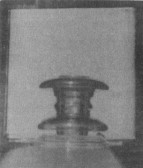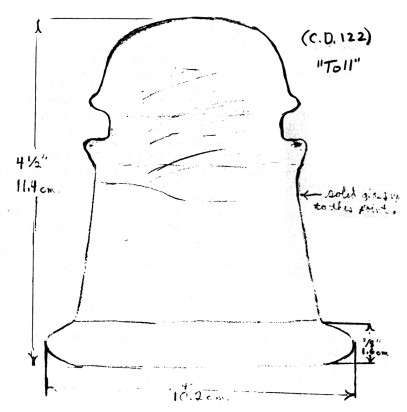Research Division
Reprinted from "INSULATORS - Crown Jewels of the Wire", October 1976, page 28
About the inquiry by Harold Van Fleet concerning the feeder wire insulator
(August issue, page 32), I can see a possible connection for the words
"Johns Pat." with the name of the founder of the Johns-Manville Co.,
H. W. Johns. This first company was located in Hartford, Connecticut, which town
name is also on the Van Fleet insulator.
I think that it is very probably that Mr. Johns patented an insulator such as
this one, although the company he started seemed to be most interested in
composition types. (See in my book, Unique Collectible Insulators, page 72.)
Gerald Brown
Dear Dora,
You were correct about Mike Doyle's insulator. (See June 1976 issue, page
36.) It was used to support the ground wire for lightning rods.
I removed three from a verticular run on a brick building in Camden, New
Jersey. They were fastened to the building by a metal flange over the enlarged
base of the insulator. Sorry I didn't recover the metal flanges which were
stamped.
Ellis M. Chisholm
72 Rose Ave.
Springfield, NJ 07081
Dear Dora,
I have a question for you. While traveling along the coast in southern
California, I noticed a few poles with some Hemingray-42's on them. Underneath
the 42's, on each thread, there was something else mounted. They looked
something like the sketch at right.

They were mounted so they were touching the insulators, and they made the
Hemingray-42's look like the porcelain U-982! (I tried to sketch the whole thing
at left.)

I couldn't tell what these things were made of, but I thought maybe
they were related to the Hemingray "Whatzit" in the June 1976 issue.
Please let me know if you've heard anything about these.
Thanks, and keep up the great work on the magazine.
Mark Willke (NIA #916)
16727 N. Abiqua Rd.
Silverton, OR 97381
- - - - - - - - -
Mark:
You've sure got me on this one. I haven't seen any of these; but perhaps some
of our linemen subscribers from southern California can answer for me. If
these are along the coast, it could have something to do with the fog.
Dora
Dear Dora,
I was just sent the biggest surprise since I have been living in New York. A
good friend of mine in Hawaii has been from there, and he has sent me some nice
castles, two blue and one green. One of the blue is mint, and the green displays mint very easily.

But
this is not what I wrote to tell you about. This friend of mine in Hawaii sent
me an odd insulator from no other place than Tahiti. It is a greenish aqua. It
has a through pin hole that tapers up--at the bottom it is one inch across, and
at the top it is three quarters of an inch across. It is about three and a
quarter inches tall and about four inches wide at either umbrella. It also has
two wire grooves between the umbrellas. On the top umbrella in the front are the
letters EIV, and on the back A 21, and also on the lower back the number 49. It
is a beautiful insulator, and I wish you could see it.
We will be in Chico around the tenth of August. I will have my EIV with me to
show you. I hope you will be home. If you will not be home, I would like to
leave it with you with a few bucks for postage after you get a good look at it.
I want to thank you very much, and I hope to see you.
Ron Witt
R.F.D. 3, Pines Bridge Rd.
Mt. Kisco, NY 10549
- - - - - - - - -
Ron:
Sorry we missed you; but I'm glad my Mother showed you our collection. Yes,
your E.I.V. is a beautiful insulator. You will find an illustration in
Milholland's 3rd Revision, page 373, that is very much like yours, except it
doesn't seem to have the tapered pinhole. There is also a big insulator on page
362 with E.I.V. embossed on it. Probably both are made by the same company.
Coming from Tahiti, I would hazard a guess that it's French. Thanks for sharing
with us.
Dora
Dear Dora,
We recently purchased what we believe to be a paperweight that was made by
the Whitall Tatum Co. It reads as follows: F- Whitall Tatum Co. No 2, B-  / Made in
U.S.A./Number. Color is clear. Enclosed is a sketch (see following page) of the
insulator or paperweight, whatever you might want to call it. Note:
/ Made in
U.S.A./Number. Color is clear. Enclosed is a sketch (see following page) of the
insulator or paperweight, whatever you might want to call it. Note:

The weird
thing about this item is that it has a solid glass disc on the bottom of it, and
it is solid glass right up to the first lip of the wire groove. We would greatly
appreciate it if you would publish the letter and sketch in your magazine, to
see if any other collectors can help us, Thank you.
Sincerely,
Ed Myslinski & Douglas Williams
- - - - - - - - -
Ed & Doug:
Thanks for showing this to us at Berea. I would like to see what our
collectors that didn't get to see it at Berea think. We guessed paperweight or
salesman's sample. Then, after arriving back in Chico and having a minute
between answering letters, I happened to glance thru the Central Florida
Insulator Club's newsletter, and here's what Bob Alexander has to say:
"Sometimes at shows a solid insulator will show up. These were made on
purpose at the factory to warm up the molds when production started in the
morning. The first three or four insulators were poured solid; from then on the
mold would be hot enough to let the glass form into all the areas of the
mold."
But this still leaves the question of the pinhole in the dome that isn't
solid glass.
Dora
| 